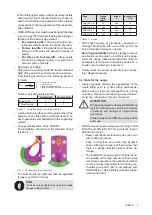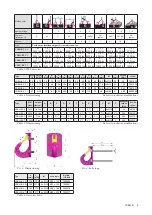
4
VABH-B
• Please check carefully the wear indicator markings
of the lifting point (see
Pic. 2
):
Use prohibited:
Replacement criteria
reached. Material all the
way down to the wear
lenses has gone.
Usage permitted
no wear marks visible
Pic. 2: Wear indicators
• Keep in mind that the lifting means in the VABH-
B must be freely movable. When attaching and
removing the lifting means (e.g. lifting chains),
crushing, shearing, trapping and impact spots must
be prevented.
• Prevent damage being caused to the lifting means
by loading at sharp edged.
• If the VABH-B is exclusively used for lashing,
the load-bearing capacity value can be doubled:
LC = Permitted lashing force = 2 x load-bearing
capacity (WLL)
HINT
If the VABH-B is/was used as a lashing
point, with a force higher than the WLL,
it must not be used as a lifting point after-
wards.
If the VABH-B is/was used as a lashing
point, up to the WLL only, it can still be used
afterwards as a lifting point.
• If possible, leave the immediate danger zone.
• Always supervise your suspended loads.
4 Inspection / Repair / Disposal
4.1 Hints for periodical inspections
The operator must determine and specify the nature
and scope of the required tests as well as the periods
of repeating tests by means of a risk assessment (see
section
4.2 and 4.3
).
The continuing suitability of the lifting point must be
checked at least 1x year by an expert.
Depending on the application conditions, e.g. when
used frequently or if there is a higher level of wear or
corrosion, it may be necessary to carry out inspec-
tions at intervals of less than a year. This inspection is
also absolutely necessary after damage and special
incidents.
The inspection cycles must be specified by the ope
-
rator.
Only RUD original spare parts must be used and all
repairing operations and service work must be docu-
mented in the chain card file (of the complete lifting
mean) or use the AYE-D.NET.
4.2 Test criteria for the regular visual
inspection by the user
• The lifting point should be complete
• Comprehensive, legible load-bearing information
as well as the manufacturer‘s identification mark.
• Correct bolt sizes, bolt quality and screw-in lengths
•
Always observe tightness of the bolts → inspect
the torque
• The excavator hook has to be mount on plane
bolting surfaces with the full back side.
• Deformations on load-bearing parts such as basic
body and bolt
• Mechanical damage, such as notches, particularly
in high stress areas.
4.3 Additional test criteria for the
competent person / repair worker
• Cross-section alterations caused by wear > 10 %
(see wear indicator markings)
• opening of the mouth is deformed > 10 %
• Strong corrosion (Lochfraß)
• Other damage
• Additional inspections may be necessary depen-
ding on the result of the risk assessment (e.g.
incipient cracks at load bearing parts).
4.4 Disposal
Dispose of the discarded components / accessories
or packaging in line with local regulations.























